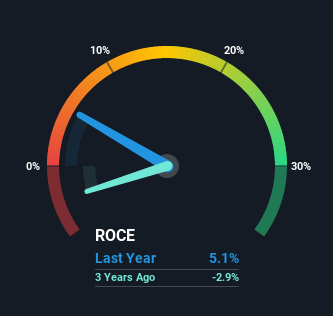Returns On Capital At DIC India (NSE:DICIND) Paint A Concerning Picture
What trends should we look for it we want to identify stocks that can multiply in value over the long term? Amongst other things, we'll want to see two things; firstly, a growing return on capital employed (ROCE) and secondly, an expansion in the company's amount of capital employed. This shows us that it's a compounding machine, able to continually reinvest its earnings back into the business and generate higher returns. However, after briefly looking over the numbers, we don't think DIC India (NSE:DICIND) has the makings of a multi-bagger going forward, but let's have a look at why that may be.
Understanding Return On Capital Employed (ROCE)
For those who don't know, ROCE is a measure of a company's yearly pre-tax profit (its return), relative to the capital employed in the business. The formula for this calculation on DIC India is:
Return on Capital Employed = Earnings Before Interest and Tax (EBIT) ÷ (Total Assets - Current Liabilities)
0.051 = ₹196m ÷ (₹5.9b - ₹2.0b) (Based on the trailing twelve months to September 2021).
Thus, DIC India has an ROCE of 5.1%. Ultimately, that's a low return and it under-performs the Chemicals industry average of 17%.
See our latest analysis for DIC India

Historical performance is a great place to start when researching a stock so above you can see the gauge for DIC India's ROCE against it's prior returns. If you're interested in investigating DIC India's past further, check out this free graph of past earnings, revenue and cash flow.
How Are Returns Trending?
In terms of DIC India's historical ROCE movements, the trend isn't fantastic. Around five years ago the returns on capital were 13%, but since then they've fallen to 5.1%. However, given capital employed and revenue have both increased it appears that the business is currently pursuing growth, at the consequence of short term returns. And if the increased capital generates additional returns, the business, and thus shareholders, will benefit in the long run.
What We Can Learn From DIC India's ROCE
Even though returns on capital have fallen in the short term, we find it promising that revenue and capital employed have both increased for DIC India. And there could be an opportunity here if other metrics look good too, because the stock has declined 15% in the last five years. As a result, we'd recommend researching this stock further to uncover what other fundamentals of the business can show us.
One more thing to note, we've identified 4 warning signs with DIC India and understanding these should be part of your investment process.
If you want to search for solid companies with great earnings, check out this free list of companies with good balance sheets and impressive returns on equity.
New: Manage All Your Stock Portfolios in One Place
We've created the ultimate portfolio companion for stock investors, and it's free.
• Connect an unlimited number of Portfolios and see your total in one currency
• Be alerted to new Warning Signs or Risks via email or mobile
• Track the Fair Value of your stocks
Have feedback on this article? Concerned about the content? Get in touch with us directly. Alternatively, email editorial-team (at) simplywallst.com.
This article by Simply Wall St is general in nature. We provide commentary based on historical data and analyst forecasts only using an unbiased methodology and our articles are not intended to be financial advice. It does not constitute a recommendation to buy or sell any stock, and does not take account of your objectives, or your financial situation. We aim to bring you long-term focused analysis driven by fundamental data. Note that our analysis may not factor in the latest price-sensitive company announcements or qualitative material. Simply Wall St has no position in any stocks mentioned.
About NSEI:DICIND
DIC India
Manufactures and sells printing inks and allied material in India.
Flawless balance sheet with low risk.
Market Insights
Community Narratives



